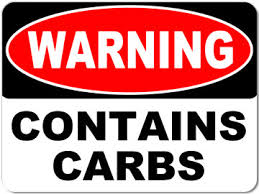Just like a car our bodies need fuel to function. Fuel can come from either glucose, fat or protein. However our primary fuel source of energy is glucose. So where does glucose come from? It comes from carbohydrates – chains of sugar molecules in food that are broken down by the liver to produce glucose (blood sugar). This increase in glucose triggers the pancreas to release a hormone called insulin which transports the glucose to your cells to be used as energy. It’s science!
Produce too much glucose and the body will store it in your liver and muscles as glycogen to be used when we need an extra quick burst of energy (working out). However our muscles and liver have a limited amount of storage capacity. Therefore excess glycogen that can’t be stored in the liver or muscles is safely stored away as FAT. Unfortunately our fat cells have an unlimited storage capacity.
Good / Bad Carbs
Carbohydrates can be divided into different groups and categories; some are good, some are not so good and some are just downright bad:
• Simple and Complex
• Refined and Natural
• Complex Starchy and Complex fibrous
Simple / Complex Carbohydrates
Simple carbs are absorbed quickly because their chain of sugar molecules is short and they will produce a rapid rise in blood sugar levels and trigger a surge of insulin to balance it. Consume too many simple carbs and you’ll soon be storing all that extra glucose as fat.
Complex carbs contain chains of sugar molecules joined together in their thousands. The body has to work much harder to break them down so digesting them takes far longer. Due to this slow absorption, energy is released at a steady rate which helps to stabilise blood sugar and insulin levels.
• Examples of simple carbs: fructose (natural sugar found in fruit), lactose (natural sugar in dairy products), glucose (blood sugar), sucrose (the sugar you put in coffee)
• Examples of complex carbs: potatoes, brown rice, whole grains and vegetables
Refined / Natural Carbs
Refined carbohydrates are the bad guys and should be avoided at all costs if you want to lose weight. Refined carbs have had all their complexity removed and have exactly the same effect on the body as simple carbohydrates.
Natural carbohydrates are those that haven’t been tampered with and remain as nature intended. If it grew that way it’s a natural carb.
• Examples of refined carbs: cakes, chocolate, doughnuts, pastries, chips, white rice, white pasta, white sugar.
• Examples of natural carbs: anything that grows in the ground or can be picked off a tree or plant!
Complex Fibrous Carbs / Complex Starchy Carbs
All the energy in starchy carbs can be absorbed by the body making them very calorie heavy and it’s very easy to overeat them so be careful. It’s best to eat starchy carbs is around workouts. Stick to smaller portion sizes usually a cup.
Fibrous carbs have numerous benefits and you should eat plenty of them! The body doesn’t absorb all the available calories from fibrous carbs because a lot of it is contained in the plant’s fibre which we can’t digest. Green leafy vegetables are very low in calories and you can eat a ton of them without reaching anything close to your calorie limit. As a result you’ll be adding lots of fibre to your diet which will make you feel fuller on fewer calories which will help you lose weight.
• Examples of complex starchy carbs: potatoes, oats, brown rice, whole grain pasta, whole grain bread and beans.
• Examples of complex fibrous carbs: broccoli, cauliflower, cucumber, lettuce, cabbage, green beans and spinach.
My carb rules:
• CARBS OTHER THAN REFINED ONES ARE NOT THE ENEMY.
• DITCH THE REFINED CARBS NOW!
• GO EASY WITH NATURAL FOODS CONTAINING SIMPLE CARBS, LIKE FRUIT. MODERATION IS KEY.
• STARCHY CARBS ARE HIGH IN ENERGY SO EAT AROUND WORKOUTS.
• EAT FIBROUS CARBS AS OFTEN AS POSSIBLE.

Leave A Comment